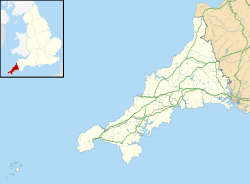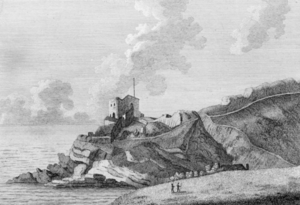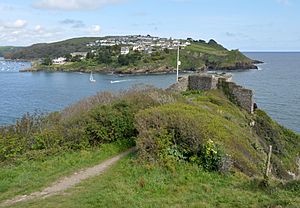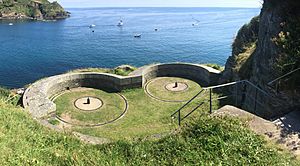St Catherine's Castle facts for kids
Quick facts for kids St Catherine's Castle |
|
|---|---|
| Fowey, Cornwall, England | |

The blockhouse of St Catherine's Castle, seen from the gun platform
|
|
| Coordinates | 50°19′41.6″N 4°38′40.0″W / 50.328222°N 4.644444°W |
| Type | Henrician castle |
| Site information | |
| Owner | English Heritage |
| Open to the public |
Yes |
| Condition | Ruined |
| Site history | |
| Built | Circa 1538–40 |
| Built by | Thomas Treffry |
| Materials | Slate rubble |
| Events | English Civil War Napoleonic Wars Crimean War Second World War |
|
Listed Building – Grade II
|
|
| Official name | St Catherine's Castle |
| Designated | 11 March 1974 |
| Reference no. | 1218875 |
St Catherine's Castle (also known as Cornish: Kastel S. Kattrin) is an old castle in Cornwall, England. It was built by Thomas Treffry around 1538 to 1540. This happened because England was worried about being attacked by France and the Holy Roman Empire.
The castle is shaped like a letter D and made of stone. It had five openings for cannons, called gun-ports. It was built high up, looking over the mouth of the River Fowey. A strong wall and the natural cliffs helped protect it.
St Catherine's Castle was used for many years. It closed after the Napoleonic Wars ended in 1815. But it was used again in 1855 during the Crimean War. Two new places for guns were added then. However, the castle soon became too old-fashioned and was left empty.
During the Second World War, the castle was made strong again. It held a group of naval guns to protect the coast from German attacks. After the war, the castle was put back to how it was before. Today, English Heritage looks after it as a place for visitors.
Contents
History of St Catherine's Castle
Why the Castle Was Built
St Catherine's Castle was built because of big disagreements between England, France, and the Holy Roman Empire. This was during the last years of King Henry VIII's rule.
Before this, kings usually let local lords and towns protect the coast. The king's government did not build many forts. France and the Empire were often fighting each other. So, while sea raids happened, a full invasion of England seemed unlikely. There were some small forts, like simple blockhouses, but not many big ones.
In 1533, King Henry VIII broke away from Pope Paul III. He wanted to end his marriage to Catherine of Aragon and marry someone else. Catherine was the aunt of Charles V, who was the Holy Roman Emperor. Charles V felt insulted by Henry's actions.
Because of this, France and the Empire teamed up against Henry in 1538. The Pope even told them to attack England. It looked like England would definitely be invaded. So, King Henry started to make his coastal defences much stronger.
Building the Castle in Fowey
To deal with this danger, a small, D-shaped stone fort was built. It was meant to protect Fowey Harbour in Cornwall. Fowey was a very important trading port back then.
The harbour was reached through the Fowey estuary (a river mouth). In earlier times, the town had protected it with two blockhouses and a chain across the river. The new St Catherine's Castle took their place. It was built high on a point of land called St Catherine's Point. This is where the castle gets its name.
Work on the castle started between 1538 and 1540. Thomas Treffry, a local gentleman, was in charge of the building. By 1540, a map said the castle was only "half-made." When a historian named John Leland visited in 1542, he stayed with Treffry. Leland wrote that Treffry and the local town helped pay for the castle's construction.
How the Castle Was Used Later
St Catherine's Castle was used for many years after it was built. During the English Civil War in the 1640s, people who supported King Charles I (called Royalists) held the castle against Parliament. In 1684, local officials said the fort was in a "ruinous" (falling apart) state.
A historian named Francis Grose visited the castle in 1786. He noted that the town was still paying to keep the fort in good shape. He liked its "picturesque and romantic" location. However, he thought the building itself was not very important for history or architecture. At this time, the castle had six cannons. It continued to be used as a gun battery until the Napoleonic Wars ended in 1815.
After the Crimean War started in 1853, people worried about invasion again. So, the coastline was made stronger. The castle was updated in 1855 as part of this work. Two new gun positions were built around the old blockhouse.
In 1887, the castle got new, powerful guns. These were supported by volunteer soldiers and used for training. But these weapons soon became old-fashioned. By the end of the century, the site was not used anymore.
The castle was used again during the Second World War. The British army used it to defend the coast from German attacks. In June 1940, it was set up as a gun battery and a place to watch for enemies. Extra concrete defences were added.
Two large naval guns were put in one of the 19th-century gun positions. Another new gun position was built 50 meters west of the castle. A French 75mm gun was also added. The old blockhouse itself was used to control a minefield in the estuary below.
Soldiers from the Royal Artillery manned the guns. But the battery was stopped from active operations in November 1943. After 1945, the entire fort was closed down. The newer defences were removed.
Today, English Heritage manages the castle. It is a popular place for tourists to visit. It is also protected by UK law as a Grade II* listed building and a scheduled monument.
Castle Design and Structure
The original 16th-century blockhouse has two floors. It is shaped like a D. Inside, it measures about 5 meters by 4.4 meters. Its walls are made of slate rubble and are up to 1.35 meters thick. They sit on a platform carved out of the natural rock.
The ground floor originally had three rounded gun-ports. These looked out over the sea and the estuary. One of these has since been filled in. On the first floor, there were two more gun-ports. One of these is also now filled in. There were also smaller windows that could have been used for smaller gunpowder weapons. The building had a fireplace and a chimney. There was also a small guard room near the entrance. The top of the building had a walkway with a low wall, called a parapet.
The blockhouse sits on a rocky point, looking out at the sea and the estuary. Cliffs surround it. There is also a curtain wall that encloses a semi-circular area of about 500 square meters. This wall has narrow openings for firing muskets. A rectangular bastion (a strong part of the wall that sticks out) protects the back of the blockhouse. It measures 5.7 meters by 3.2 meters inside, with walls 0.75 meters thick.
The original path to the blockhouse was blocked by later changes. The steps you use to get to the building today were built in the 19th century.
In the 19th century, a flat-roofed magazine (a place to store gunpowder) was cut into the rock below the blockhouse. A gun platform was also built. It had two round spaces for gun carriage rails. A granite parapet protected this platform. The curtain wall was also changed during this time. You can still see plaques on it marked "WD 1855." You can also still see the marks from the extra defences added during the Second World War along the gun platform.
Images for kids









